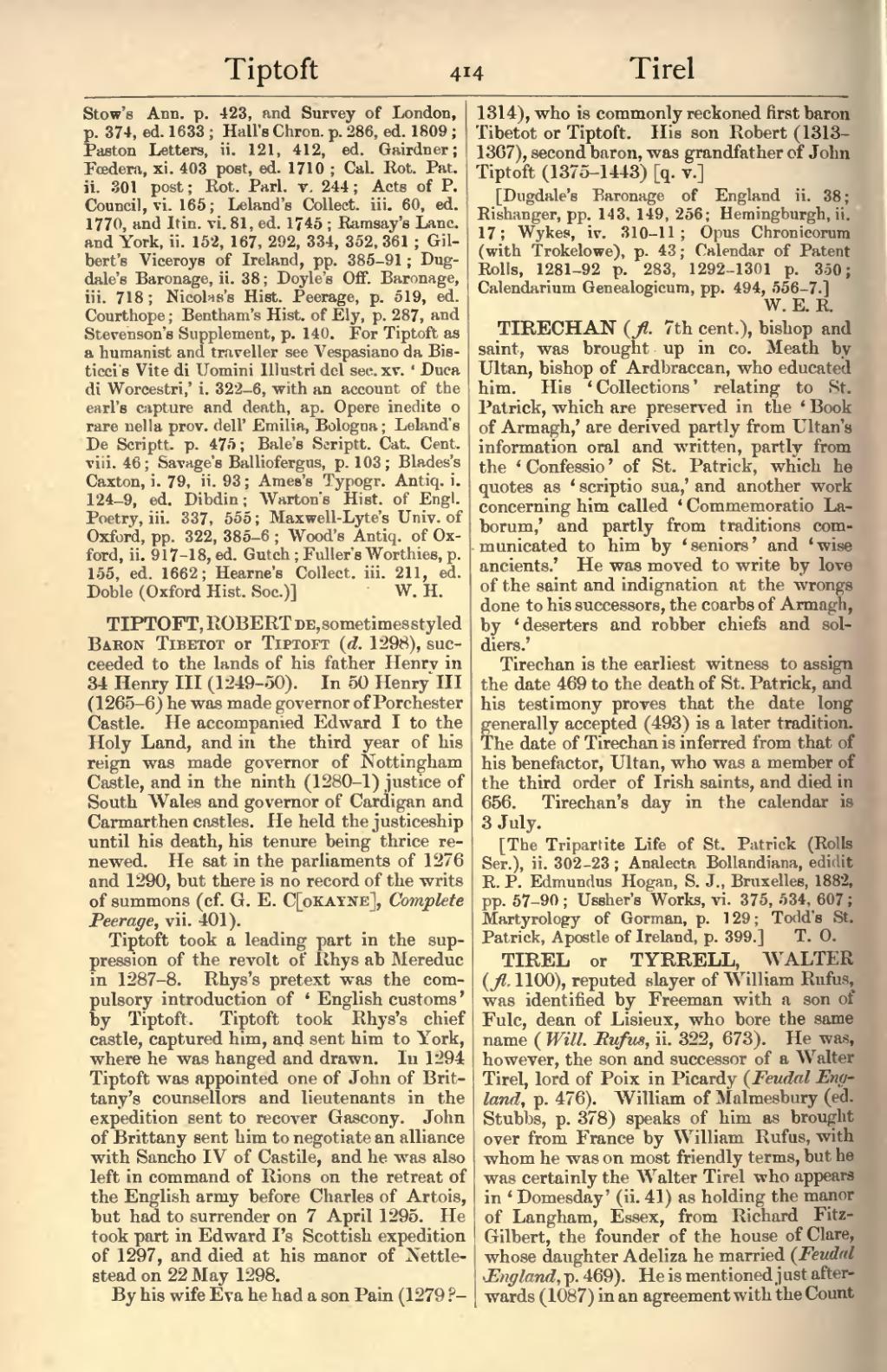TIPTOFT, ROBERT de, sometimes styled Baron Tibetot or Tiptoft (d. 1298), succeeded to the lands of his father Henry in 34 Henry III (1249–50). In 50 Henry III (1265–6) he was made governor of Porchester Castle. He accompanied Edward I to the Holy Land, and in the third year of his reign was made governor of Nottingham Castle, and in the ninth (1280–1) justice of South Wales and governor of Cardigan and Carmarthen castles. He held the justiceship until his death, his tenure being thrice renewed. He sat in the parliaments of 1276 and 1290, but there is no record of the writs of summons (cf. G. E. C[okayne], Complete Peerage, vii. 401).
Tiptoft took a leading part in the suppression of the revolt of Rhys ab Mereduc in 1287–8. Rhys's pretext was the compulsory introduction of ‘English customs’ by Tiptoft. Tiptoft took Rhys's chief castle, captured him, and sent him to York, where he was hanged and drawn. In 1294 Tiptoft was appointed one of John of Brittany's counsellors and lieutenants in the expedition sent to recover Gascony. John of Brittany sent him to negotiate an alliance with Sancho IV of Castile, and he was also left in command of Rions on the retreat of the English army before Charles of Artois, but had to surrender on 7 April 1295. He took part in Edward I's Scottish expedition of 1297, and died at his manor of Nettlestead on 22 May 1298.
By his wife Eva he had a son Pain (1279?–1314), who is commonly reckoned first baron Tibetot or Tiptoft. His son John (1313–1367), second baron, was grandfather of John Tiptoft (1375–1443) [q. v.]
[Dugdale's Baronage of England ii. 38; Rishanger, pp. 143, 149, 256; Hemingburgh, ii. 17; Wykes, iv. 310–11; Opus Chronicorum (with Trokelowe), p. 43; Calendar of Patent Rolls, 1281–92 p. 283, 1292–1301 p. 350; Calendarium Genealogicum, pp. 494, 556–7.]
TIRECHAN (fl. 7th cent.), bishop and saint, was brought up in co. Meath by Ultan, bishop of Ardbraccan, who educated him. His ‘Collections’ relating to St. Patrick, which are preserved in the ‘Book of Armagh,’ are derived partly from Ultan's information oral and written, partly from the ‘Confessio’ of St. Patrick, which he quotes as ‘scriptio sua,’ and another work concerning him called ‘Commemoratio Laborum,’ and partly from traditions communicated to him by ‘seniors’ and ‘wise ancients.’ He was moved to write by love of the saint and indignation at the wrongs done to his successors, the coarbs of Armagh, by ‘deserters and robber chiefs and soldiers.’
Tirechan is the earliest witness to assign the date 469 to the death of St. Patrick, and his testimony proves that the date long generally accepted (493) is a later tradition. The date of Tirechan is inferred from that of his benefactor, Ultan, who was a member of the third order of Irish saints, and died in 656. Tirechan's day in the calendar is 3 July.
[The Tripartite Life of St. Patrick (Rolls Ser.), ii. 302–23; Analecta Bollandiana, edidit R. P. Edmundus Hogan, S. J., Bruxelles, 1882, pp. 57–90; Ussher's Works, vi. 375, 534, 607; Martyrology of Gorman, p. 129; Todd's St. Patrick, Apostle of Ireland, p. 399.]
TIREL or TYRRELL, WALTER (fl. 1100), reputed slayer of William Rufus, was identified by Freeman with a son of Fulc, dean of Lisieux, who bore the same name (Will. Rufus, ii. 322, 673). He was, however, the son and successor of a Walter Tirel, lord of Poix in Picardy (Feudal England, p. 476). William of Malmesbury (ed. Stubbs, p. 378) speaks of him as brought over from France by William Rufus, with whom he was on most friendly terms, but he was certainly the Walter Tirel who appears in ‘Domesday’ (ii. 41) as holding the manor of Langham, Essex, from Richard FitzGilbert, the founder of the house of Clare, whose daughter Adeliza he married (Feudal England, p. 469). He is mentioned just afterwards (1087) in an agreement with the Count
